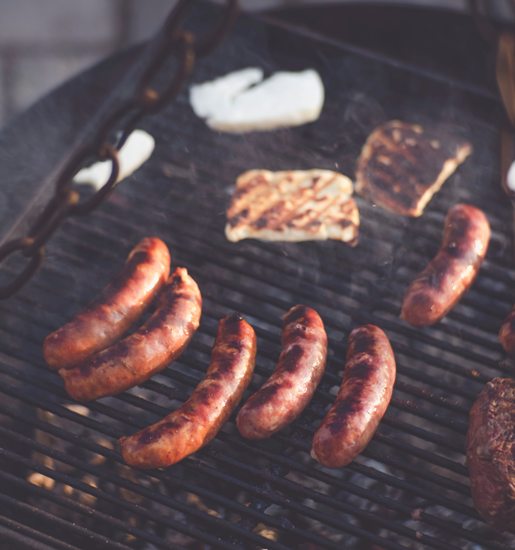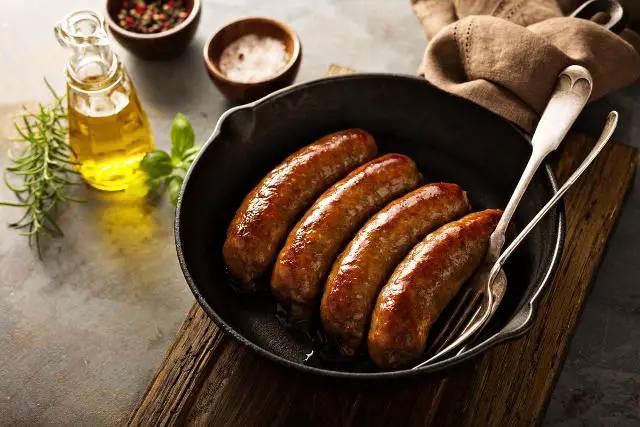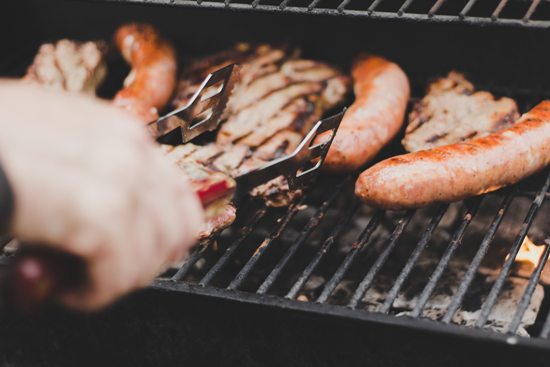Cold smoked sausages are an excellent way to infuse a robust smoky flavor while maintaining the original texture.
The remarkable benefit? This process allows you to store sausages for multiple days or even weeks, so you can enjoy the flavor at your convenience. However, be aware that cold smoking sausages demands additional precautions.
Given the potential for bacterial contamination during smoking, particularly for newcomers to the procedure, exercising heightened care is paramount. Novices are advised to begin with low-risk foods like tofu or eggs, allowing them to acquaint themselves with the process before delving into sausage.
This method permits the acquisition of initial cold smoked experience with a lower likelihood of mishaps involving sausages.
For individuals well-versed in the technique, here’s a practical, step-by-step guide to ensure your upcoming cold-smoking venture unfolds effortlessly!

Table of Contents
Why Cold Smoke Sausages?
Cold smoking is a culinary technique where food is exposed to smoke at low temperatures for an extended duration.
Unlike hot smoking that employs high heat for rapid cooking, this method uses smoke to slowly cook the food, resulting in a more tender, moist end product infused with a distinct smoky flavor.
It finds use across various foods, with a pronounced popularity for smoked meats like bacon, sausage, and ham.
The low-temperature cooking involved imparts a unique texture and flavor to the food, setting it apart from dishes that are hot-smoked.
Steps for Cold Smoking Sausages

There’s no need to feel daunted by the concept of cold smoking. With a handful of expert insights, the procedure can be streamlined.
Allow me to impart some time-honored wisdom from renowned Texan grill masters.
1. Preparing Your Equipment
You don’t need to spend a fortune to set up your cold smoking equipment. DIY a cold smoke generator or purchase one – either way, it doesn’t have to be fireproof.
If you want to buy a smoker, be sure to do your research to find out which one is best for you. There are many different types of smoking machines to choose from, each with different prices.
Perhaps you can’t afford a large smoker or don’t have the space to store one, so you might consider purchasing an attachment for your grill. You might want to start with a cheaper option if you’re a beginner, or you might prefer to invest in an expensive smoker right from the beginning.
I like the Lanney Smoker Tube for food smoking – it’s inexpensive, small, and can attach to my grill.
As for the food chamber, your regular barbecue works just fine as long as it has a lid to capture the smoke and a chimney to let excess smoke escape. It creates a separate unheated chamber where the sausages will stay while the smoke slowly flavors them.
Airflow plays a critical role in smoking. It ensures the smoke evenly spreads throughout the food chamber and prevents trapping it, which would spoil the taste of your sausages.
2. Choose a Wood for Smoking
Using a variety of wood chips like maple, hickory, alder, apple, or cherry is essential to give your sausages a unique flavor. The smaller the chips, the better, as chunks create too much smoke.
Avoid wet wood, as it burns unevenly and affects the quality of the final product.
3. Curing Your Sausages Before Smoking
To transform your sausage links into savory, succulent bites of heaven, you must first give them a good cure. The curing process not only adds flavor but also extends the sausages’ shelf life.
So, right now is when you want to add a special ingredient – curing powder. You have a couple of choices here: Prague Powder #1 or Prague Powder #2.
Now, if you’re planning to cook the meat afterward, go with Prague Powder #1. But if you’re aiming to dry-cure your meat down the road, then Prague Powder #2 is your choice.
Get a bowl and mix together the perfect blend of salt, sugar, and spices. With your expertly crafted mixture, rub it all over the sausage links until every inch is coated in a flavorful crust.
Once you’ve completed this crucial step, place the links on a rack in your fridge and let them chill for a full day, allowing the curing magic to work its wonders.
4. Get Your Smoker Ready
One of the most critical steps in cold-smoking sausage is to preheat your smoker. Depending on the type of smoker you have, it can take anywhere from 30 minutes to an hour to get it ready.
Once your smoker is preheated, it’s time to arrange your sausage on the wire racks or hang them from rods if your smoker has the option. This will allow the smoke to circulate evenly around each sausage link.
5. Place the Sausages in the Food Chamber
While using wire racks in your food chamber or barbeque can be effective, they do demand more maintenance. You’ll need to rotate each sausage every hour to ensure even smoking.
As an alternative, suspending them in a barrel-type food chamber is another viable choice, but ensure the sausage links do not come into contact with each other.
Before placing your sausage on the grill, make certain they are thoroughly dry. The drier the sausage casing, the more pronounced the smoky flavor you’ll achieve.
Monitor the wood chips closely and replenish the smoker with fresh ones once the previous batch has burnt out completely. After a few hours, a noticeable shift in the sausage color will occur.
The pivotal factor is the consistent maintenance of low temperatures throughout the entire process.
6. Cook the Sausages
Now, it’s time to cook it up to perfection. Place them on the grill or in a skillet, and cook until they’re fully cooked through.
Don’t forget to allow them to cool before flipping them over to cook evenly on both sides. Once fully cooked, remove them from the heat and cover until ready to serve.
If you’re wondering how to smoke fresh sausage, the process is almost the same, taking around 2 to 3 hours to achieve that mouth-watering flavor.
Online, there’s an abundance of recipes. The variety you go for will depend on the type of sausages you’re aiming to prepare.

How Long Can the Cold Smoking of Sausage Take?
The longer the process, the better the flavor.
You should keep your sausage on the grill for at least eight hours, but to ensure food safety, it’s recommended for 24 hours.
Patience is key!
Since you’re not cooking the meat, just infusing it with a smoky flavor, you’ll need to cook it afterward.
The sausage need to reach 30°C (85°F) during the cold smoking process. To be safe for consumption, cook them at temperatures up to 80°C (176°F).
If you’re not planning on cooking the sausage right away, you can store them in a sealed container in the fridge. Alternatively, putting them in the freezer can help prolong their quality and prevent bacterial growth.
Which Foods Are Optimal for Cold Smoked? (Types)
While sausage often steal the spotlight, the world of smoking offers a diverse array of culinary possibilities, each promising to tickle your taste buds and awaken your senses.
Meat
As the cornerstone, meats have long held a special place in this ancient culinary technique.
And let’s not forget the irresistibly savory delights of bacon and ham, as they too emerge with heightened flavor and an undeniable allure.
Fish
But meats aren’t the only stars of the cold smoked show. Fatty fish, with their rich textures, willingly submit to the smoldering embrace of cold smoke. The outcome? Fish that boasts a denser mouthfeel and a seductive smokiness.
The likes of trout, salmon, whitefish, grayling, and even tuna find themselves on this flavor-enhancing journey, emerging as the embodiment of gourmet excellence.
Cheese
Cold smoking and cheese share a harmonious bond. From mozzarella to cheddar, Swiss cheese to pepperjack, and the enchanting notes of Gouda and Fontina.
Eggs, Fruits, and Veggies
Did you know that even eggs, after a gentle boiling, are open to the enchantment of cold smoking? Soft or hard, they offer yet another layer of complexity to the palette of flavors.
And speaking of surprises, the smoking repertoire extends to fruits and vegetables. The natural textures, colors, and nutritional prowess remain intact, as lemons, apples, peaches, grapes, pineapples, tomatoes, potatoes, garlic, and onions.
Also read: How to hang snack sticks in a smoker.
Expert Tips to Perfectly Smoking Process

Here are some creative tips.
Start with Small Smoked Batches
If you’re new to smoking, it’s best to start with smaller and simpler items, such as cheese, nuts, or vegetables, to familiarize yourself with the process.
As you become more comfortable with cold smoking, you can gradually move on to sausage, salami, and other meat products.
Following a Recipe Can be a Game-Changer
Hunt down a recipe that sounds lip-smacking good to you.
Whether it’s a seasoned pitmaster’s creation or just a random find on the web, these recipes are your go-to for your maiden cold smoking journey.
After you’ve tested out a few and you’re not feeling like a greenhorn anymore, that’s when you can start to do your own thing and add your twist.
Also, consider being a taste explorer. Grab some cold-smoked sausages from diners or markets to get a feel for the flavors you want in your creation.
It’s like a research mission to nail down that ideal recipe and taste you’re aiming for.
Be Aware of Health Risks
Cold smoking meat can be more risky than hot smoking because the cold smoking environment promotes the growth of harmful bacteria and parasites.
Hot smoking, on the other hand, technically cooks the meat and reduces potential risks by eliminating the bacteria.
Smoking in Ideal Conditions
Since cold smoking produces a lot of smoke, it’s best to do it outside. Cooler temperatures are optimal, as too much heat can lead to bacteria growth.
However, it’s also not ideal to smoke in extremely cold conditions, as it may be difficult to maintain a low temperature. In this case, consider adding a heat source to the chamber or waiting for the weather to warm up.
Use Low Heat for Cold Smoking
To ensure the perfect flavor, you don’t want the wood chips to burn or create flames. Instead, they should burn slowly and steadily.
Make sure to check every few hours to ensure that the wood chips don’t burn completely. Also, be sure to leave enough space between sausage on the grill to allow for even smoke absorption.
Proper Ways to Store Your Sausages
After smoking, you can cook and eat your sausage fresh or store them for later. To keep the smoky flavor locked in, store them in plastic zipper-lock bags, aluminum foil, or plastic wrap.
For maximum flavor, you can leave them wrapped for a few days to allow the smoke to penetrate the meat even further.
Sausage recipe
Cold smoker, venison, smoking takes place, smoke penetration, uncured sausage, smokehouse, smokai, bratwurst, chorizo.

Fernando is the creator and writer behind the food blog Eating with your Hands. Living and working in cities like Paris, Barcelona, and Berlin, and being married to a Canadian foodie, has given Fernando a passion and interest in food and inspired him to run EWYH.
